This image by Donald Hobern from Copenhagen, Denmark, has licence: CC BY 2.0 <https://creativecommons.org/licenses/by/2.0/>
Gardening with Indigenous Plants
Indigenous Plant Use
Identification & Control of Common Weeds
| Botanical Name: | Microtis sp |
| Common Name: | mignonette orchids, onion orchids |
| Sold As: | Tube ($2.00) |
| Plant Type(s): | Orchid, Insect Attracting, Indigenous Plant Use |
| Indigenous Plant Use: | The tuber can be eaten (probably cooked, don't know about in it's raw state).CAUTION: Many plants are poisonous if not collected and prepared properly! |
| Growing Conditions: | Full Sun, Partial Shade
Dry, Moist, Well Drained |
| Size (HxW): | 10-80 cm high |
| Foliage: | Single erect leaf to 70 cm, sheath opening well below flowerhead |
| Flowers: | Flowers are green to yellowish from November to January and are pollinated by insects. |
| General Comments: | This is a perennial, deciduous, sympodial herb with a few inconspicuous, fine roots and an egg-shaped to almost spherical tuber. Plants in the genus "Microtis" are hard to tell apart (so we are bunching them together). The leaves of onion orchids are susceptible to fungal disease and most leaves appear to have some damage. The rust Uromyces microtidis has been identified as a pathogen. Use of orchids in gardens is not recommended, unless they already occur naturally, in which case they need to be protected. |
 Further Information: |

